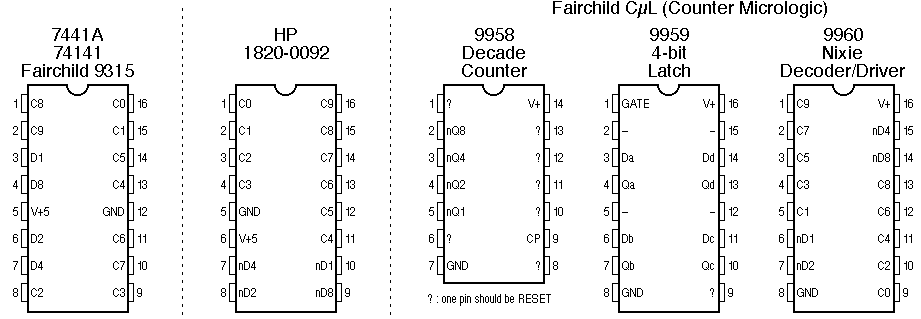| |
|
NIXIE Driver ICs
|
| Device |
Technology |
Logic
0/1 |
Output for Input>9 |
| A |
B |
C |
D |
E |
F |
| 7441A |
TTL |
L/H |
0 |
1 |
2 |
3 |
4 |
5 |
| 74141 |
TTL |
L/H |
none |
none |
none |
none |
none |
none |
| Fairchild 9315 |
TTL |
L/H |
2, 8 |
3, 9 |
none |
none |
6 |
7 |
| Fairchild 9960 |
CµL (RTL) |
H/L |
2, 8 |
3, 9 |
4, 8 |
5, 9 |
6, 8 |
7, 9 |
| HP 1820-0092 |
? |
H/L |
none |
none |
none |
none |
none |
none |
|
|
| |
Following is a list of NIXIE decoder/driver integrated circuits and comparison of some their characteristics.
7441A & 74141
The standard TTL NIXIE decoder/drivers.
The 7441A was the first released sometime in the late 1960s.
It wasn't long before it was replaced by the 74141 which is pin-compatible but provides blanking capability via input values greater than 9.
Fairchild 9315
The 9315 is from Fairchild's early 9300-series TTL series.
The Fairchild 9960 & Counter MicroLogic
The 9960 is something of an odd device.
It is part of a small series of ICs Fairchild produced in the 1960s called Counter Micrologic.
The series included 4 ICs - a decade counter (9958), 4-bit latch (9959), NIXIE decoder/driver (9960) and a less-frequently-seen base-16 counter (9989).
The series was intended for decade counter strings in instruments such as frequency counters and other digital meters.
The electronic design puts the series in the RTL class and they typically operate with a 3.6V supply, although they are rated for V+ up to 5.5V.
The 9960 has been found directly driven by TTL devices and 5V supply.
The 9960 inputs sink 1.3mA @ +3.6V (high/logic-0) and open-circuit is equivalent to low/logic-1.
The ICs of this series may be confusing to identify as the labelling can vary in form.
The 9960 for example, may be identified as type 960 or may have a longer label such as "F 996079" or "U6B996079X".
HP 1820-0092
A proprietary device manufactured by Hewlett-Packard in the late 1960s.
These were used in conjunction with special HP decade-counter ICs (1820-0093 and 1820-0119) to achieve zero-blanking in their digital counters of the late-1960s, such as the HP 5216A.
It is not clear what technology this device is, it operates at 5V in systems with TTL ICs, but the inputs sink 1.5-1.7mA @ +5V when high and open-circuit is equivalent to low, suggesting RTL.
My experience with these devices shows them to be failure-prone.
I would guess that a lot of HP equipment using them has been discarded due to failure of these ICs and the difficulty of replacing them.
In my opinion, these ICs are best reserved for replacement in equipment that requires them, rather than scavenging them for use in new construction.
Pinouts

- IC packages as viewed from above.
- Dx = binary data input
- Cx = output to cathode for numeral x, goes to ground when active.
Source of Data:
- 7441A: National TTL data book 1976
- 74141: TI TTL data book
- 9315: Fairchild TTL data book 1978
- 9960: Fairchild catalog 1966, observation of device
- 1820-0092: observation of device

